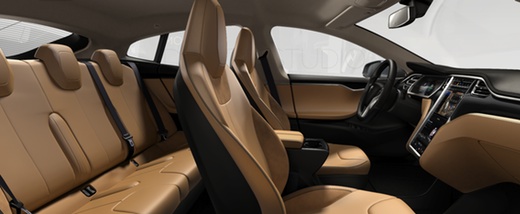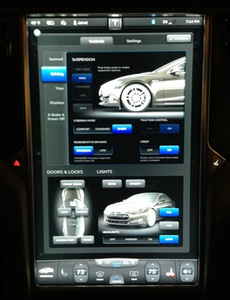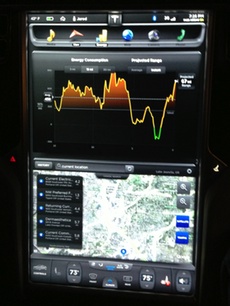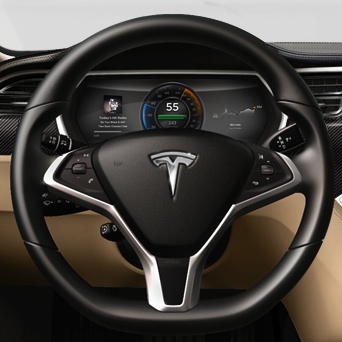Last night, thanks to a friend (let's call him Jake, since that's his name) with a position in the buying queue, I was able to get some extended (passenger only) time in a Tesla Motors Model S—more specifically, the Model S Peformance, loaded to the gills with pretty much every option available.
Jake was concerned about the car's clearance into and out of his somewhat steep driveway, so the dealer agreed to let him (with an onboard sales rep, of course) take the car home to test it out. I rode out as a back seat passenger, and got to ride back to the dealership in the passenger seat. So what was it like? In short, it's an amazing technological tour de force that elicits grins with every punch of the accelerator.
First impressions
The Model S is a large car (it can seat seven, with two optional rear-facing child seats under the back glass). It's beautifully sculpted, though, and sits quite low to the ground. So my initial walk-up opinion was simply "that's a stunning car!"

There are all sorts of touches befitting a six-figure luxury sports sedan, i.e. keyless door opening, keyless start, remote trunk and frunk (front trunk) opening, door handles that pop out from their flush position, puddle lights to illuminate the ground near the car, auto headlights, auto wipers, heated seats, and tons more.
Exterior
I walked around the car completely, and couldn't find an angle where it looked bad. Even directly from the back, where many modern cars fall flat, the Model S looks sharp. Because there's no engine, there's a lot of usable storage space up front; the frunk would easily hold a few large suitcases. If that's not enough room, there's a ton of space under the rear hatch.
The panel fit was first-class; I was looking for misaligned panels, or varying gaps, but they all looked tight and consistent. In short, this doesn't look like a brand new car from (basically) a brand new car company.
Interior
The interior of the car is incredibly rich feeling, and very well designed. It's pretty amazing what designers can do with no need to stick to a traditional notion of a car's interior.

Entering the rear seats is relatively easy, though the door doesn't open quite as widely as I was expecting. Once seated, the rear seats were quite comfortable, and there was a ton of legroom. About the only issue is headroom, as that gorgeous sloping rear hatch intrudes if you try to sit fully back—I'm six feet tall, and my head would just brush the roof if I did so. For children, though, it would be a palatial environment.
There's no center armrest for rear seaters, but the car is wide enough to seat three adults across. And because there's no center tunnel for the driveshaft, there's no issue with the center seater having nowhere to put his/her feet. While the window is still preferable for the views, the center wouldn't be a bad place to pass the time.
The only real downside I saw to the interior was a lack of storage space. The glovebox is quite small, and the center console contains two drink holders, but no storage space. Newer models have a shelf below the center console where you can place an iPhone or similar device, but you're not going to be hiding three atlases, a pile of DVDs, and assorted kid stuff anywhere in this car.
This car was equipped with a huge panoramic roof covering front and back seats. The front section opens; the back is essentially a huge skylight. I'm not sure how well this would work on a hot sunny day (there's no interior cover), but on a clear night, the effect was impressive.
Riding back to the dealership in the front seat, headroom wasn't an issue, and there was legroom galore, even if I moved the seat forward quite a ways. Moving the seat back, I was surprised at how far back it goes; I could nearly stretch my legs straight out with the seat all the way back. The seat heaters are effective, and work on both the bottom cushion and the lower portion of the back cushion.
In short, the interior of the Model S is a very pleasant place to spend time. It feels as rich and well designed as any higher-end automobile I've ever been in, which is quite an achievement for a newcomer. During our drive, I didn't hear any squeaks or rattles, which is another sign of a car that's been put together in a solid manner. Kudos to Tesla for sweating the details.
The console
 Glancing up front from the back, the thing that captures your eye is the massive 17" panel that is the entirety of the center console.
Glancing up front from the back, the thing that captures your eye is the massive 17" panel that is the entirety of the center console.
Really, there's nothing else there, except two smallish buttons: one to the left of the panel activates the hazard blinkers, and one to the right opens the glovebox. At right is a somewhat fuzzy picture (click it for the larger version) I took from the back seat, using the iPhone. The sales rep pointed out that this was "version 4.0" of the software, and it had just recently been installed via an over-the-air update. (Future day conversation: "Honey, did you unplug the car during the update last night? I can't start it this morning…")
Everything you want to do with the car, you do it through this interface. (There are some switches and buttons on the steering wheel for often-used functions, so you don't always have to go to the screen.) This photo shows the panel that lets you set the active suspension, steering mode, traction control, regenerative braking, and lights. The car includes ambient lighting, which uses subtle white LEDs in the doors to gently light the cabin at night.
The regenerative braking, when set to Standard, is fairly impressive—take your foot off the gas, and the car will actively decelerate—so much so that the brake lights illuminate. You can easily come to a complete stop without touching the brake pedal. The Low mode provides sensations more like a real car, where you'll get a fair bit of coasting when you lift off the throttle.
The three Steering Mode settings affect wheel feedback; Jake's response was something like "oh, ewww, yech!" It seemed to me that it basically put the Model S in "Buick mode," though thankfully the ride has no similar setting. Jake's preference was clearly Sport mode. If you disable traction control on this screen, you can (I'm told, we didn't test this, darn it) easily smoke the tires.
 Exiting the settings screen, the image at right (another iPhone shot) is the normal interface for the console; again, click the image for a larger version.
Exiting the settings screen, the image at right (another iPhone shot) is the normal interface for the console; again, click the image for a larger version.
You control what you see via the row of buttons near the top—Media, Nav, Energy, Web, Camera, and Phone. Tap and hold a button, and you can choose whether it appears in the top or bottom position (Navigation can also go full screen, which is jaw-droppingly lovely to look at.)
The bottom section is always present, allowing fast access to the dual-zone climate controls, seat heater, and audio volume.
Navigation is via Google Maps, and it's fairly good—with the Tech Package, you get voice guided assist, traffic information is displayed, and everything is really easy to see. But really, you'd get all of that with any nice off-the-shelf Garmin unit. But there's a level of integration here you won't find in any Garmin; I'll cover that integration while discussing the instrument panel.
At the very top of the console is a status row, much like you'll see on an iPhone (click for a larger version):
The car can store any number of driver profiles, remembering seating and mirror positions for all drivers; the currently chosen profile (Jared, in this case) appears in the status bar.
The instrument panel
One of the things I really liked about the Model S is that there is no traditional instrument panel, per se. There are no (to steal an aviation term for 'old technology') steam gauges to be found; the instrument cluster is simply another display screen:

The instrument panel is clean and elegantly designed. There's a digital speed display is in the center of the middle circle, with a "fuel gauge" of sorts below that. The blue curving bar gauge on the left of the circle is a traditional sweeping speed indicator, and the orange curving bar gauge on the right of the circle shows energy consumption; it turns green during regenerative braking.
When navigating, the area to the left of the speedometer and center dial is replaced with a small 3D view of the route, showing upcoming turns. It's a great idea, and makes it easy to keep navigating without having to avert your eyes to the center console. (If not navigating, I believe this area displays song and artist information, but I'm not positive about that.)
The area to the right of the speedometer can do a lot; it will show a graph of energy consumption, and when you want it, you displays a menu of controllable features via a steering wheel switch. For instance, you can open or close the sunroof by calling up the menu, scrolling to the Sunroof entry, then choosing the desired position (which can be anywhere from open to closed; it can be set in 1% increments).
While it's nice that there's a somewhat easier way to get to the sunroof (and other) controls via this menu system, this does demonstrate the value of traditional switchgear. Opening or closing the sunroof in my car requires nothing more than reaching for a roof-mounted switch and holding it down until the roof has reached the desired position. The Model S method is undeniably more technically cool, but practically, it'll be a pain (especially around Portland, where sudden showers are the norm, not the exception).
Connectivity
One big gotcha in the car at the moment is the question of connectivity. The demonstrator we were in had some sort of 3G connection. Production cars, however, do not include any sort of 3G connectivity. They can only connect to the net by pairing with a net-enabled device, "or wifi," the sales rep helpfully added (which clearly won't be very useful at speed).
The sales rep mentioned they're still trying to sort out what sort of connectivity they may offer—do they find a bunch of different providers for customers, or do they pick one in order to provide the best rate? As it stands now, though, having to rely on a cell phone's connectivity seems like a half-baked solution.
Performance
Saving the best for last, this car's performance is nothing short of extraordinary. Zero to 60 takes 4.4 seconds, but it feels like even less than that, thanks to the instantaneous torque available from the electric motors. When Jake stomped on the gas pedal, all four of us were pressed back against our seats, and the speedo simply rocketed up to, well, some speed you're not supposed to reach, I'm pretty sure—at least not in the time it took us to reach it!
My car is quite quick to 60, but there's no comparison in feel between the two; the instant torque makes accelerating in the Model S a grin-inducing affair. There's no sign of the car's massive weight (4,647 pounds) when accelerating or cornering, either. Body roll is minimized; the car just seems to go where it's pointed, and goes there quickly.
Of course, there are a couple caveats to this performance. If you spend your driving time playing drag racer, you'll not go anywhere near the car's 300 mile maximum range. The bigger caveat is that you get this absolutely stunning acceleration only in the loaded, $87,400 base price, Model S Performance version.
Start with the 40kWh version (base price $50K), and you get a 160 mile range and 6.5 second zero to 60 time. Step up to the $60K base model, and you get 230 miles and 5.9 seconds; at $70K, you get 300 miles of range and a 5.6 second zero to 60 time. So if you want the best performance, you're going to pay for it, and pay quite dearly.
Final thoughts
The Model S is a stunning technological achievement. A car that can rip to 60 in 4.4 seconds, travel hundreds of miles on a single charge, easily recharge in less than a night, carry seven in comfort and style, and do it all without directly burning an ounce of gasoline is nearly unbelievable. I believe that, in many ways, the Model S represents the future of the automotive industry.
As amazing as the Model S is, though, the electric-only powertrain means that it cannot replace my gasoline powered car. Long road trips are out, unless you want to limit yourself to something under 300 miles a day. (The I5 corridor will be outfitted with a series of fast-charge stations that can get to an 80% charge level in 30 minutes; this will make longer coastal trips possible, once the network is in place.)
Also out are shorter trips to destinations that lack charging stations, as you won't be able to refill before the return trip—a car camping trip, for instance, could be troublesome.
If I need to justify the expense (and I clearly do!), then the car needs to be able to fully replace my current car's duties, and the Model S, despite its impressiveness, can't yet do that.
Clearly if I had the money just lying around the house looking for something to do, and I didn't have any thoughts of longer excursions, there's no doubt I'd find a way to get a Model S into the garage. It's a beautiful car with luxurious interior appointments and incredible performance that doesn't use any gasoline. And to me, that's borderline magical, and something I'd love to drive on a regular basis. Maybe in 10 years or so…
The photos of the exterior, interior, and instrument panel were borrowed from the Model S Gallery page; I took the various photos of the console in action.
